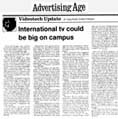International TV Could be Big On Campus
By Maurine Christoper
Ronald Reagan has deftly proved that anyone with ambition, drive and health doesn’t have to waste time worrying about age.
Yet counterbalancing that encouraging note comes a sign that I clearly was born too soon.
Oh, to be in college now. They are talking about gearing up earth stations, computers, adapters and other necessary equipment to bring tv in by satellite from at least 10 countries in as many languages. When I attended Tusculum College in Greeneville, Tenn., we read countless books in German and French but rarely heard a colloquial sentence spoken in those foreign tongues.
“How about being able to go into the dormitory and turn on cable to choose from CBS on Channel 2. Moscow on Channel 3. Rio on Channel 4 and Paris on Channel 6?” enthused Ken Schaffer, chairman of Orbits Technologies Corp.
The New York engineering whiz, who rigged up the earth station and other equipment to bring Soviet TV from the U.S.S.R. satellites down to the rooftop of Columbia University last year, no
w has a patent pending for a system to provide access to other European and South American tv programs and news as well.
Mr. Schaffer, inventor of the wireless electric guitar, said his company can install a multinational, multi-satellite setup for educational and other institutions for $56,500.
Meanwhile, having proved at Columbia that his Orbita terminal imports a pretty decent live picture from the Soviet Union, he is busy marketing his product to 75 other prospects from universities, State education departments and federal agencies.
This intricate U.S.S.R.-only system, which includes color and tv standard adapter to accommodate U.S.-made tv receivers, is priced at about $50,000.
So far, Columbia’s Averell Harriman Institute for the Advanced Study of the Soviet Union is the only place in the U.S where Russian tv is being regularly picked up live from the U.S.S.R. domestic satellites. Even the folks at the Soviet embassy in Washington can’t watch tv from home while stationed here. They are an obvious hot prospect for Orbits if the necessary government approval comes through from Moscow.
As this column went to press, three other universities reportedly had ordered Mr. Schaffer’s package for round-the-clock access to Soviet tv. Outside contributors are paying for the sensitively positioned earth Station and other essentials.
When first approached to follow in Columbia’s footprints. some university professors were so disdainful of U.S. tv that they weren’t interested in even talking about bringing in Soviet programs and news. However, many of them, and the administrators who must approve such installations, reportedly have been impressed by the favorable impact of the trailblazing project.
Some professors have suggested they might want to buy cassettes from Columbia University for their Russian study courses.
“They are missing entirely what this is all about,” Mr. Schaffer told me. For him, as well as for the Students I visited with in the viewing room in Manhattan, the main stimulation comes from watching Soviet tv live (even though much of it may have been taped earlier) today, at the same moment when millions of Russians are watching. Many of the programs themselves are dull, stodgy and antiquated-looking.
Orbita’s multinational terminal could be an even more valuable educational tool than the Russian-only model. The U.S.S.R. domestic satellites do not bring programs within reach of America until 4 p.m. ET). Shows from elsewhere could be run during the rest of the day.
Further, Soviet studies, if offered, are a relatively small department at many colleges and universities If the international satellites used by the U.S.S.R. and other European countries and South America are reachable, then French, German and Spanish departments could enjoy the benefits of foreign pictures from the sky.
The third stage of Mr. Schaffer’s satellite plan would open up two-way communications between American and Soviet Students. “Once we get going at a number of universities, why not an uplink trailer to go on location to American campuses?” the former rock ‘n’ roll producer and special-effects expert suggested. “The Americans could talk to a roomful of students in Moscow. And the boy in the front row in the U.S. says to the girl standing in the back in Moscow, ‘How about your phone number? You’re cute.'”
ADVERTISING AGE

